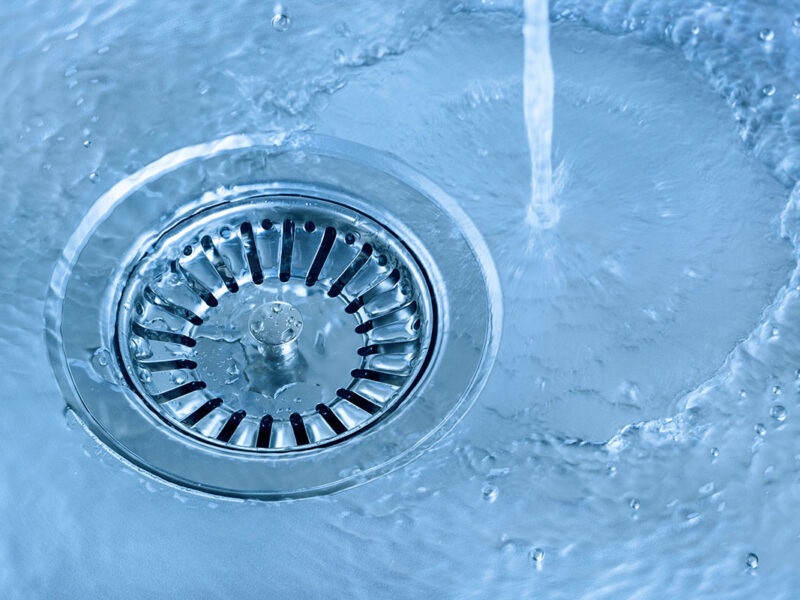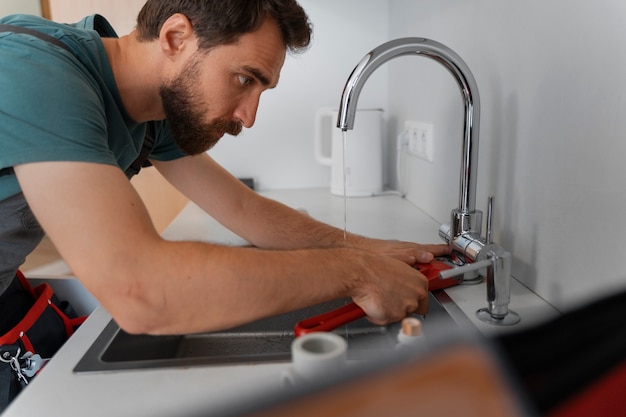Handy Tips For Repairing A Slow-Draining Sink
Handy Tips For Repairing A Slow-Draining Sink
Blog Article
Nearly everybody may have their unique opinion when it comes to Solved! How to Fix a Slow Sink Drain.

Intro
We have actually all existed: You're cleaning your teeth or cleaning your hands, and you observe the water pooling in the sink. Rather than promptly swirling down the tubes, it lingers, transforming your once-refreshing early morning regimen right into a small overload scene. A slow-draining sink isn't just annoying; it's often a sign of larger pipes concerns hiding under the surface area. Fortunately is that a lot of slow-draining sinks can be fixed with a little expertise, a few fundamental tools, and some perseverance. Prepared to tackle this project head-on? Let's roll up our sleeves and dive right in.
Recognizing the Causes of a Slow-Draining Sink
Before you begin poking around in your pipelines, it aids to recognize what could be causing the downturn. Understanding the source makes it easier to select the best solution.
Tools and Products You'll Require
The right devices make all the distinction. Thankfully, you won't need a completely equipped plumbing technician's van to get the job done.
Step-by-Step Guide to Fixing a Slow-Draining Sink
Now, allow's get involved in the nitty-gritty. This detailed process will certainly direct you through basic strategies to restore your sink's drainage.
Action 1: Eliminate and Clean the Stopper
Typically, the stopper (that little plug you push down to block water) is the first offender. Remove it meticulously and wipe any hair or substance trapped around its base. Rinse it extensively before putting it back in position.
Step 2: Make Use Of a Bettor to Dislodge Debris
Got that bettor ready? Setting it over the drain and give it a few company pumps. The idea is to create suction that can loosen any type of obstruction. If you see littles debris floating up, you get on the ideal track.
Step 3: Try a Drain Serpent or Cable Wall Mount
If the plunger does not suffice, it's time to bring out the drain serpent. Carefully feed it into the drain and spin as you go. You could really feel some resistance-- that's most likely the blockage. Keep twisting and pulling until you remove the blockage. If you don't have a drainpipe serpent, a corrected the alignment of cable hanger can operate in a pinch.
Tip 4: Apply a Do It Yourself Drain Cleaner
An all-natural cleaner made from cooking soft drink and vinegar can break down recurring crud. Pour half a mug of cooking soft drink right into the drainpipe, followed by half a mug of vinegar. Let it fizz for around 15 minutes, after that flush with warm water. This chemical reaction often does marvels for minor clogs.
Step 5: Reconstruct and Test the Sink
Put everything back together and run the tap. Does the water currently swirl down the drain at a commendable speed? If yes, provide yourself a pat on the back. If not, don't anguish-- there are still a couple of even more dress up your sleeve.
Necessary Devices for Do It Yourself Fixes
A plunger is your go-to beginning factor. A tiny, sink-sized plunger creates suction that can dislodge small blockages. For even more persistent blockages, a drain snake (in some cases called a plumbing technician's auger) functions wonders. A pair of gloves, a flashlight, and possibly a set of protective safety glasses are additionally convenient.
Advised Cleansing Solutions
Light meal soap and hot water can assist break down greasy accumulation. A blend of baking soft drink and vinegar is a tried and true home remedy, and enzymatic cleaners supply a more green strategy. Maintain chemical drain cleaners as a last hope, as they can be rough on your pipes.
Usual Offenders Behind Slow Water Drainage
So, what's clogging things up? Generally, it's a mix of day-to-day particles-- think hair, soap scum, toothpaste residue, and leftover food particles. In time, these tiny bits accumulate and hold on to the pipeline walls, gradually narrowing the flow and making it harder for water to travel through. In many cases, natural resource from tough water can likewise contribute to the gunk, producing the perfect tornado for stubborn clogs.
When is it Time to Do Something About It?
If you observe the water draining slower than common, it's a great idea to intervene faster as opposed to later on. Waiting also long could cause finish obstructions, undesirable smells, and even pipeline damages. If the water takes more than a couple of secs to clean out after shutting off the faucet, consider it a warning and prepare to place on your DIY hat.
Safety First: Precautions and Prep work
Before you launch into unclogging setting, consider safety and security. You're handling potentially dirty water and particles, so slip on a pair of handwear covers. If you're utilizing chemical cleansers, make sure the room is well-ventilated and adhere to the instructions on the tag.
Protective Equipment and Work Area Setup
Put down some old towels or cloths around the sink location to capture splashes. Remove any kind of things that could get in your method, like soap dispensers or toothbrush holders. Make certain you have good lights-- order a flashlight if required.
Different Techniques for Stubborn Clogs
Not all obstructions are developed equivalent. If your sink still declines to work together, think about these alternative remedies.
Sodium Bicarbonate and Vinegar Method
We currently discussed this, however it's worth keeping in mind once more. This gentle, environmentally friendly method is much safer than chemical cleansers and typically rather reliable.
Chemical Drain Cleaners
Enzyme-based cleansers utilize natural microorganisms to digest organic matter. They're an excellent option if you're looking to avoid harsh chemicals. Just remember, they might take a bit longer to function their magic.
Chemical Drainpipe Cleansers: Advantages And Disadvantages
Chemical cleansers can blast with hard blockages quick, but they're not without drawbacks. They can create warmth and fumes, damages pipelines if utilized excessively, and position environmental threats. Utilize them sparingly, and always follow the directions very carefully.
Safety Nets to Maintain Your Sink Flowing
Prevention is the most effective cure. By embracing a couple of easy behaviors, you can maintain your sink from slowing down to begin with.
Routine Cleaning Habits
Clean down the sink basin and component area on a regular basis. Eliminate hair or food bits prior to they have a possibility to wash down the drainpipe.
Preventing Unsafe Substances Down the Drain
Hesitate prior to unloading coffee grounds, grease, or fibrous veggie scraps down the sink. These wrongdoers hold on to pipe walls, producing blockages over time.
Regular Maintenance Checks
Schedule a fast regular monthly evaluation. Run hot water through the sink for a few mins, taking notice of the circulation. If it appears slow, act quickly before it comes to be a full-on obstruction.
When to Call an Expert Plumber
Sometimes, no matter just how tough you attempt, that obstruct simply will not move. That's when it's time to bring in the pros.
Indications That Indicate a More Major Issue
If your sink drains gradually regardless of numerous efforts, or if you observe water supporting in other fixtures (like your shower or bathroom), you might have a more significant pipes concern lurking deeper in the system.
Stabilizing DIY Efforts with Professional Help
While do it yourself can save you cash and provide a sense of success, there's no pity in calling a specialist. A professional plumbing technician can assess your whole pipes configuration, guaranteeing there's no underlying damage or long-term problem that might cost you much more in the future.
Contrasting Prices and Long-Term Solutions
Before choosing, think about the big picture. An inexpensive, quick fix might resolve the problem momentarily, however investing in a more irreversible service could save you money and stress over time.
Evaluating the Costs of Do It Yourself vs. Professional Solutions
Do it yourself fixes commonly cost bit greater than the cost of a plunger or a container of cooking soda. Specialist solutions, on the other hand, included a cost but might protect against repetitive concerns and expensive fixings later on.
Purchasing High Quality Fixtures and Upgrades
If your sink's design adds to constant blockages, it might be worth updating to higher-quality components or changing the pipes design. Consider this an investment in your home's functionality and convenience.
Conclusion
A slow-draining sink can seem like a minor inflammation, however it's usually a sign that your pipes needs a little TLC. By recognizing the origin, using the right tools and strategies, and dedicating to straightforward preventive measures, you can keep your sink moving freely. And when all else stops working, never hesitate to call a professional-- your home's plumbing deserves the investment in treatment and maintenance.
Three Common Ways to Fix a Slow Drain
Baking Soda Method
Boil a full pot of water. Measure out cup of baking soda and pour it down the drain. Then take cup of the magical cleansing substance known as white vinegar and drop that down there too. Allow the mixture to fizz in the drain for five minutes as the vinegar and baking soda combine. Now dump in that whole pot of boiling water. This combination of cleaning substances should clear out anything that is causing your sink to drain slowly. If it doesn t...
Zip-It
If the baking soda method doesn t clear out your drain, it may be because a significant amount of hair and/or other debris has collected there and you need to remove it. Purchase a Zip-It tool at any home improvement or hardware store and insert it into your drain. It will catch any collected hair or debris that s blocking the flow of water. Pull it out. If it s got a big clump of hair, etc. on the end, you ve probably got your culprit.
Drain Cleaner
If these methods don t work, there is the standard drain cleaner that you can also buy in a hardware store or even your local grocery store. It s better if you can use a household solution, but these drain cleaners often work in a pinch. They re very simple to use. You generally just dump them in your drain and wait. If even this method is not effective, it may be time to call the plumber.
https://www.mrrooter.com/oneida/about-us/blog/2017/july/three-common-ways-to-fix-a-slow-drain/

Hopefully you enjoyed our article on . Thanks a ton for taking time to read through our blog post. For those who appreciated our blog entry if you please remember to pass it around. I thank you for your readership.
Call Today Report this page